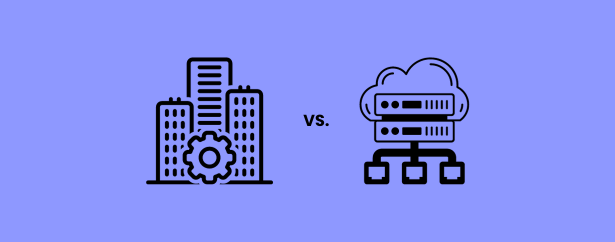You are familiar that Product Information Management (PIM) software has become a popular tool for businesses in the ecommerce industry. It helps businesses to manage product information, streamline workflows, and reduce time-to-market. It is difficult to understand On-premise vs. Cloud PIM for the ones who took longer to implement the right PIM.
In this blog, we will explore the differences between on-premise vs. cloud PIM, what are their pros and cons, and help businesses make informed decisions in the meantime.
Also, we have already covered a detailed article on Cloud PIM, do have a look into it and gain more knowledge, so that you have a better idea.
What is On-Premise PIM?
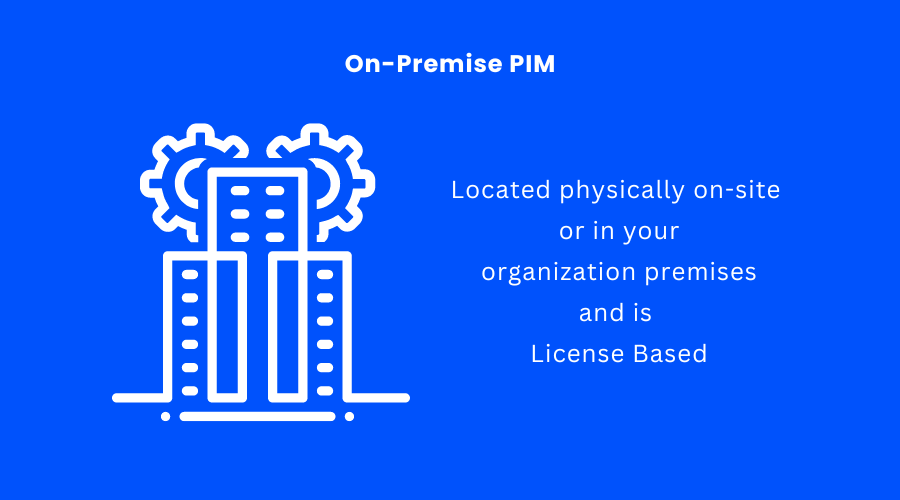
When you read the name, it is obvious that on-premise PIM refers to software that is installed and hosted on an organization’s physical premises or offices. The organization purchases and licenses the software and is responsible for implementing it on their own servers.
What is Cloud PIM?

As the name suggests, a cloud PIM refers to a software solution hosted by a third-party provider on the cloud. Once you have purchased the license to the service, you can access the PIM software from anywhere in the world and at any time. When the software is on a subscription basis, your software vendor will make the software accessible to you.
Not sure which PIM is the best for your business?
Apimio PIM got you covered, book a demo & speak to our experts for personalized advice.
On-premise Vs. Cloud PIM: Pros and Cons
The location of hosting is the key difference between on-premise and cloud PIM. It’s important to have knowledge about the pros and cons of both the PIMs before deciding which PIM would be the most suitable for your business. Let’s take a closer look at these factors.
On-Premise PIM: Pros

On-premise PIM has the following pros;
1. Data control
Using on-premise software gives you full control over your data and its storage and access since the software is stored on your own servers. You’ll also be able to easily make any necessary configuration changes or updates within the server.
2. Accessibility
As the software is located within your servers, you won’t have to rely on an internet connection to access it, ensuring easy accessibility, and you will not be impacted by any connectivity issues that may arise.
3. Security
You can ensure high-level security measures are in place to protect the confidentiality and integrity of your information, as the software is solely within your IT infrastructure.
4. Integration
This PIM software can be integrated more easily with other internal systems, such as ERP, CRM, or other legacy systems.
On-Premise PIM: Cons

On-premise PIM has the following cons;
1. Resources
On-premise software implementation requires a significant investment of IT resources, which can be challenging for smaller businesses that lack the necessary resources. Still, it will not be a much more challenging thing for established businesses.
2. Implementation
Implementing on-premise software can be time-consuming and labor-intensive. It often involves coordinating multiple experts within the organization to set up equipment, install, test, and run the software on various computers. Providing remote access to offsite workers adds another layer of complexity to the implementation process.
Have you made up your mind to choose the Cloud PIM?
Well, Apimio PIM is the right one for you, switch today and see the difference yourself.
3. Costs
Implementing the on-premise PIM can cost you a lot. The cost of licensing, hardware, servers, installation, storage, ongoing maintenance, updates, and security control can be high, along with the expense of hiring a team to manage these tasks.
4. Scalability
If your data volume grows, additional server capacity will be required to accommodate the increased product volumes, and it will make scalability a potential challenge for on-premise software.
Cloud PIM: Pros
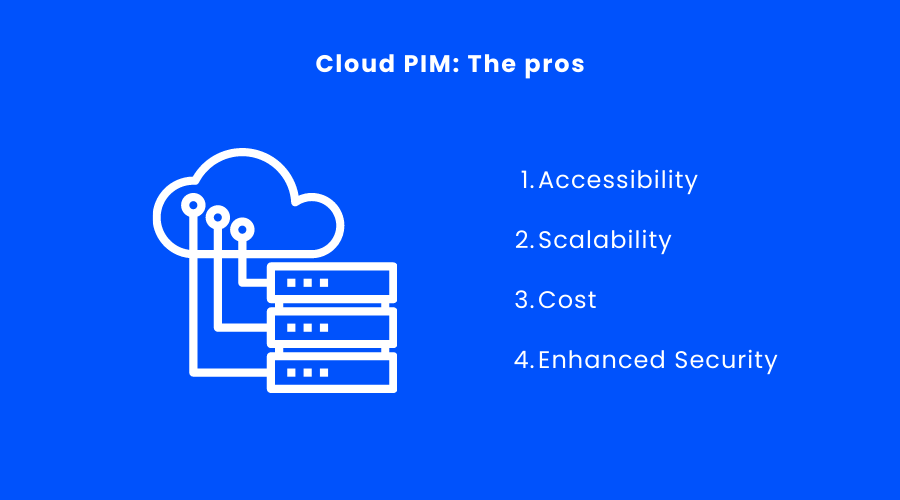
Here, I’m highlighting all the possible pros of a Cloud PIM;
1. Accessibility
Cloud PIM allows you to access your product information from anywhere with an internet connection, making it easier to manage your data while working remotely or from different locations around the world.
2. Scalability
Cloud PIM can be easily scaled up or down depending on your needs, allowing you to manage large amounts of product information without having to worry about server capacity or other technical limitations.
3. Cost
Cloud PIM is less expensive than the on-premise one. Cloud PIM offers a fixed subscription model that clearly outlines the package’s services. This usually covers everything from onboarding to maintenance and security support, making it easier to understand the costs involved.
4. Enhanced security
This PIM typically provides robust security measures to protect your data, including encryption, firewalls, and access controls.
Cloud PIM: Cons
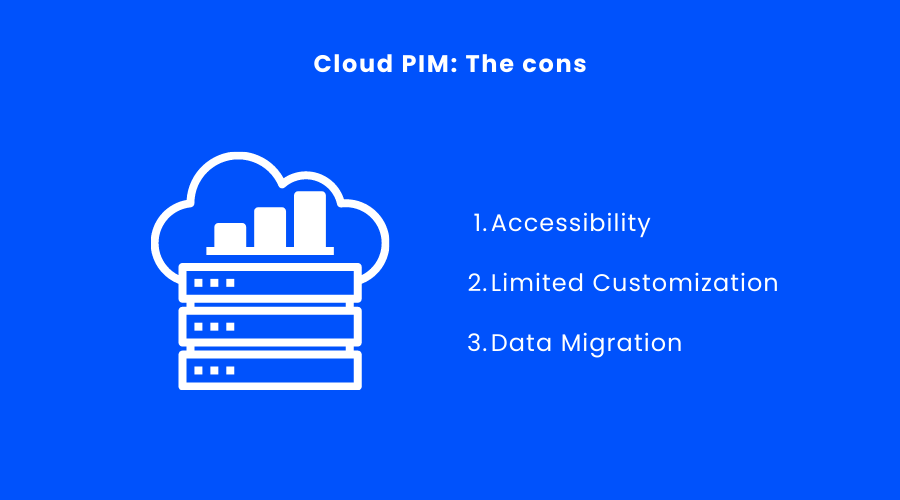
Cloud PIM has the following cons;
1. Accessibility
As cloud PIM depends on an internet connection, any disruptions that happen to your connectivity could affect your ability to access or update your product information.
2. Limited customization
Cloud PIM solutions may not offer the same level of customization as on-premise solutions, which can limit your ability to customize the software according to your business’s specific needs.
3. Data migration
If you are transitioning from an on-premise PIM to a cloud-based PIM, you may face challenges in seamlessly migrating your data to the cloud.
On-Premise Vs. Cloud PIM: Which one is ideal?
Choosing the right Product Information Management (PIM) solution for your business can lead to the best utilization of the platform, increased productivity, and improved quality of product data. As a result, you can provide exceptional product experiences that can enhance conversion rates and boost your online revenues.
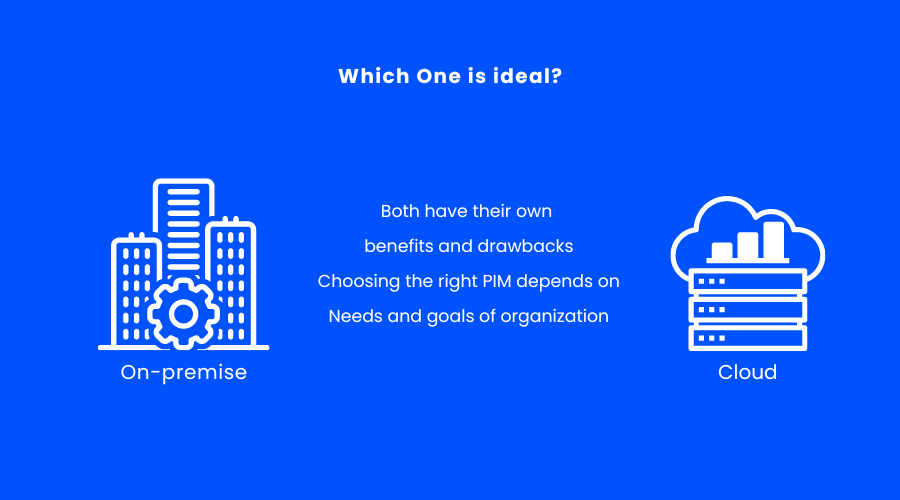
An On-Premise PIM system is installed and maintained on your organization’s servers, providing complete control over the data and the system. On-premise PIM systems typically require significant upfront investments in hardware, software, and maintenance and may require dedicated IT staff to manage the system.
On the other hand, a Cloud-based PIM system is hosted on a remote server, and the data is accessed through the internet. This type of PIM system is ideal for organizations that want to minimize upfront investment, require flexibility in scaling the system, or have limited IT resources.
Both cloud PIM and on-premise PIM have their benefits and drawbacks, and the best option depends on the specific needs and goals of the organization. Organizations that value scalability, low maintenance, and accessibility may prefer cloud PIM. While those who value control and security and have the necessary resources may prefer on-premise PIM.
Conclusion
Investing in a high-quality PIM solution like Apimio PIM can give your business the competitive edge it needs to succeed in today’s fast-paced digital marketplace. It has a cloud-based platform and seamless integrations with popular e-commerce platforms.
Apimio PIM can help streamline your product data management. And ensure that your product information is accurate and up-to-date across all channels. Don’t fall behind the competition; upgrade your product data management with Apimio PIM today and watch your sales grow!
What to do next?
- If you want to integrate Cloud PIM into your business, Try Apimio. Sign up here.
- Read more about our Product Information related Guides here.
- Contact our support or Comment your thoughts under the blog section if you have any questions or issues.
Frequently Asked Questions
A cloud-based PIM is usually the best option for small businesses because it offers lower upfront costs, faster implementation, and easier scalability.
On-premise PIMs usually require higher upfront costs for hardware and software licenses, while cloud-based PIMs offer a subscription-based pricing model with lower upfront costs.
On-premise software/hardware is installed and runs on a company’s own servers, while cloud solutions are hosted on remote servers and accessed through the internet.
